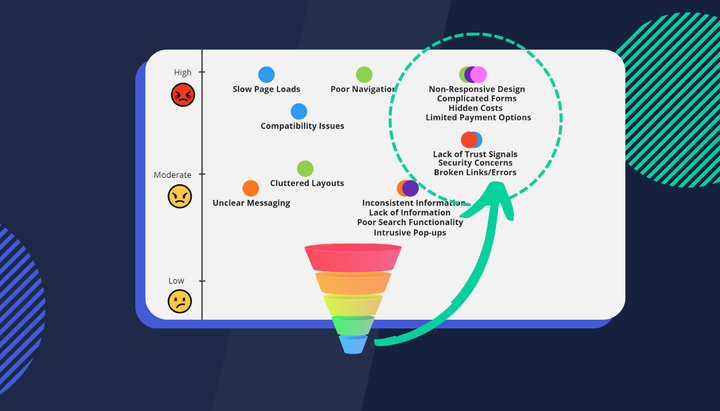Top 5 Ecommerce UX Trends in 2024
In this article, we’ll explore the top five ecommerce UX trends you need to watch out for and implement in your strategy.

Staying ahead of user experience (UX) trends is crucial for maintaining a competitive edge. As we move into 2024, several key trends are emerging that can significantly enhance the user experience on ecommerce platforms. In this article, we’ll explore the top five ecommerce UX trends you need to watch out for and implement in your strategy.
1. Personalised Shopping Experiences
Personalisation continues to be a major trend in ecommerce but did you know that only 27% of businesses are completely satisfied with their capacity to create genuinely tailored customer experiences using data acquired across digital channels (Aberdeen). This is despite 77% of consumers choosing, recommending, or paying more when brands provide a personalised service or experience (Forrester).
In 2024, this goes beyond simply recommending products based on past purchases. Advanced AI algorithms can now create highly personalised shopping experiences by analyzing user behaviour, preferences, and real-time data. This includes personalised landing pages, dynamic content, and tailored promotions that cater to individual users' needs and preferences.
Why It Matters: Personalisation can significantly improve customer satisfaction and conversion rates. Customers are more likely to purchase when they feel that the shopping experience is tailored to their specific needs.
2. Voice Commerce
In 2021, voice-assisted shopping was an emerging market valued at $4.6 billion. By 2023, it had skyrocketed to an impressive $19.4 billion, with projections indicating a 54% growth rate heading into 2024.

Voice commerce is becoming increasingly popular as more consumers use smart speakers and voice assistants like Alexa and Google Assistant for shopping. In 2024, optimising your ecommerce site for voice search will be essential. This includes implementing natural language processing (NLP) for better search results and creating voice-activated features that enhance the shopping experience.
Why It Matters: Voice commerce offers a hands-free and convenient shopping experience, which can attract a broader audience and increase sales.
3. Augmented Reality (AR) and Virtual Reality (VR)
AR and VR technologies are transforming the way customers interact with products online. Over the next five years, this sector is expected to grow 9% and reach a valuation of $62Bn by the year 2029.

AR allows users to visualise products in their real environment using their smartphones, while VR offers immersive shopping experiences that can replicate in-store browsing. In 2024, integrating AR and VR into your ecommerce platform can provide customers with a more engaging and informative shopping experience.
Why It Matters: AR and VR can reduce the uncertainty of online shopping by allowing customers to see how products will look and fit in their real lives, leading to higher satisfaction and lower return rates.
4. Enhanced Mobile UX
With the increasing use of smartphones for online shopping, enhancing the mobile user experience is more important than ever. In 2024, ecommerce sites should prioritise mobile-first design, fast loading times, and intuitive navigation. Features like one-click purchasing, mobile wallets, and responsive design are critical for providing a seamless mobile shopping experience.
Why It Matters: A smooth mobile experience is crucial for capturing the growing segment of mobile shoppers and reducing cart abandonment rates.
To monitor how shoppers are interacting on mobile devices (for example, measuring the conversion rate impact of behaviours such as rage clicks) you could use experience analytics software such as Insightech. Free trials can be requested here to unlock instant insights your team can utilise today.
5. Sustainable and Ethical Shopping
Consumers are becoming more conscious of the environmental and ethical impact of their purchases. Products marketed as sustainable grew 2.7x faster than those that were not (the roundup). In 2024, ecommerce platforms that highlight sustainable practices, eco-friendly products, and ethical sourcing will appeal to this growing demographic. Incorporating features such as carbon footprint calculators, eco-friendly packaging options, and transparent supply chains can enhance your brand’s appeal.

Every website and business is unique (as are its visitors) so you'll need to tread carefully before jumping straight into it. What works for others might not work for your brand so a cautious test-and-learn approach is suggested to see if conversion rates are improved. One way this can be done accurately (and quickly!) is with content page analysis. Insightech can help you better understand which content drives the most conversions on your website and does it visually so this can be shared with others in your team. To learn more, request a trial and we'll be in touch once we have capacity on our end.
Why It Matters: Addressing sustainability and ethical concerns can build trust and loyalty among consumers who prioritise these values in their shopping decisions.
Conclusion
As we enter 2024, embracing these ecommerce UX trends can help your business stay ahead of the competition and provide exceptional shopping experiences. By focusing on personalisation, voice commerce, AR/VR, mobile optimisation, and sustainability, you can enhance user engagement, satisfaction, and ultimately, conversions. Stay tuned to these trends and be ready to adapt your strategy to meet the evolving expectations of your customers.



